Rock is a varied, complex, and wonderful form of music. Many people think it’s all rip-roaring drums, heavy guitar riffs, and screaming voices. There’s certainly a lot of rock & roll like that, but it’s much more diverse than that.
With rock’s diversity comes a wide array of instruments. Rock remains centered around the electric guitar and drums that formed it, but they are by no means its only instruments. In fact, any instrument you can name has probably been used before, from kazoos to bagpipes.
I will examine several of these instruments. First, I will cover the ubiquitous instruments – guitar, drums, and voice – before diving into some unique ones.
Table of Contents
The Instruments That Created Rock
Guitar
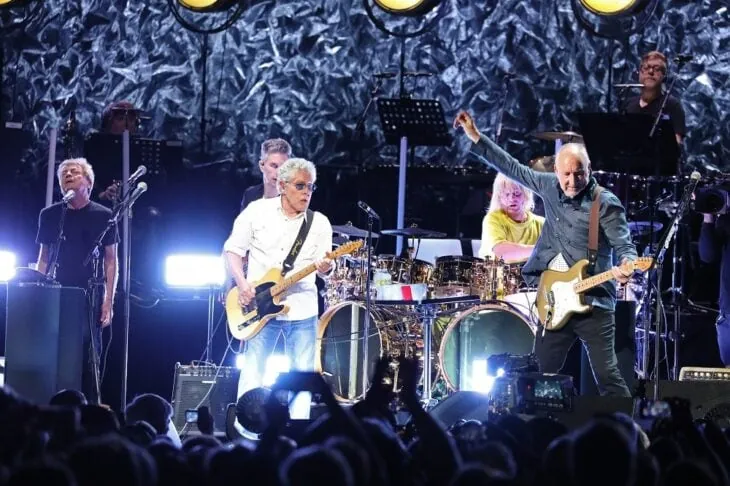
The guitar pairs with rock like peanut butter with jelly (in the US at least … we’re weird, I know!) We all know about the guitar, so I’ll just mention a few details about its connection to rock.
First off, electric guitar “just happened” to get paired with rock. Musicians first started amplifying guitars electronically in jazz bands during the ‘20s and ‘30s so they could be heard over big bands.
Later in the ‘40s and ‘50s, blues musicians like Muddy Waters did the same thing so they could be heard in loud urban bars. At some point, somebody figured out that a maxed-out guitar actually sounded pretty cool.
Around the same time, teenage culture was emerging during the ‘50s and blues was becoming mainstream. As a result, the rock culture came to fruition at the exact time the electric guitar was being pioneered.
This happy accident was almost too perfect – the distorted guitar went perfectly with the energetic music of the youth.
Most rock bands have two electric guitars; one is the “lead,” which plays the solos and melodies, and the other is the “rhythm,” which accents the beats and chords. Additionally, the bassist outlines the chords and plays the bassline in counterpoint.
While the electric guitar is synonymous with rock, the acoustic has been used just as often. Every band, from the Rolling Stones to Oasis, uses it.
Bass Guitar
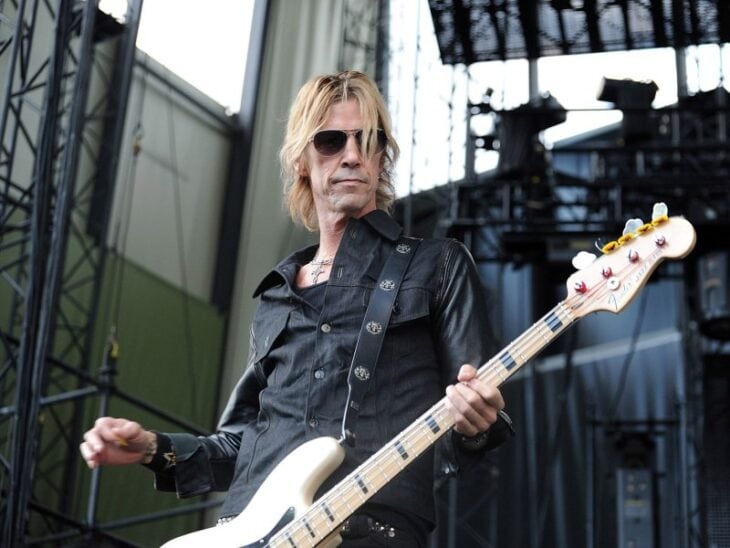
While technically a guitar just like the ones above, the bass guitar functions very differently from rhythm and lead. With their beefy set of four strings, bass guitars have the job of outlining and accenting the foundation of a tune’s chords.
Bass notes are important in music as a whole, regardless of genre. They give an aural foundation to what you hear, and let the listener know what the song’s chord structure is.
But while outlining harmony is simple in concept, bassists have a tremendous amount of space to be creative. Simple bass lines can pluck out the root of each chord with quarter notes, making harmonic progressions very clear.
Bassists can also spice up their lines by including walking notes, which may or may not be the tonic of a chord. Taking this further, they can create new melodies that compliment the main melody – just like classical counterpoint!
Famous bassists known for their melodic playing include Andy Rourke of the Smiths and Krist Novoselic from Nirvana.
Harmony aside, bassists also give rock a defining groove and beat, often matching the drums in defining rhythms. Classic examples of bass-driven rock songs include Deep Purple’s “Smoke on the Water,” and Queen’s “Another One Bites the Dust.”
Drums
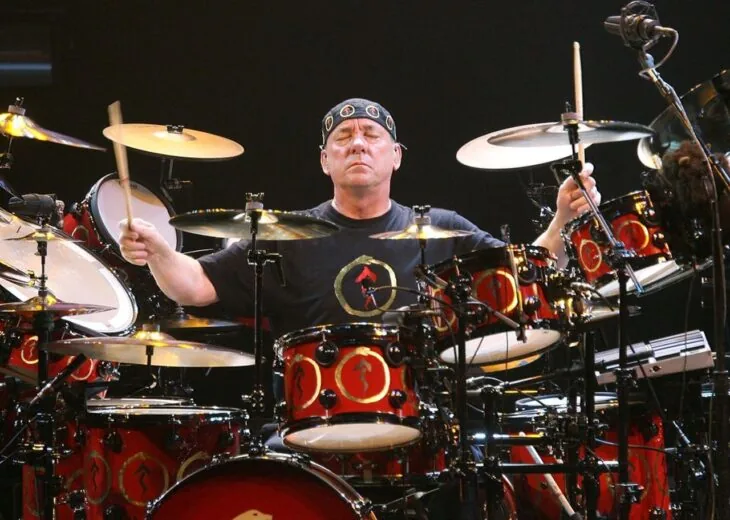
Popular music through the ages often made the beat and rhythms primary over melody and harmony. However, rock took this to a whole new level by literally “banging it out” explicitly on a drum kit.
Drum kits were first made in the early 1900s so that a single person could cover all the percussion parts in traveling circuses. Soon, jazz musicians were using them to imply jazz’s propulsive swing.
However, rock and the blues were the first global styles that made the beat the main focus of a song, making sure that listeners heard every beat and offbeat.
At the time, many jazz musicians criticized rock drums for being too garish. But rock & rollers didn’t care – that’s exactly what they wanted!
Voice
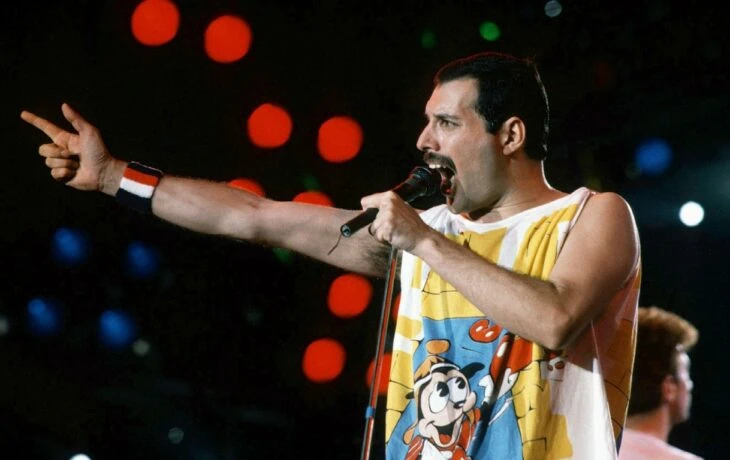
Last but not least, rock has always had a very unique vocal style. Just like any genre, rock vocal styles have evolved and changed over the years.
‘50s rock singers imitated soul singers. ‘60s rockers focused on harmonies and energy. By the ‘70s, punk rockers were singing in a consciously sloppy way. And who doesn’t know about the screaming vocal belts of ‘80s metal bands?
Pedal Perks!
You may not “play” pedals in the traditional sense, by strumming or hitting or pressing. However, their use is essential to creating the sounds and effects that make rock what it is.
Pair this fact with their buttons and knobs, and you have instruments that may be easy to “play” (just stomp on it!), but have deep and far-reaching functions.
Furthermore, they are not restricted to guitar use. In fact, any electronic instrument can be paired with them. We will look at several other electronic instruments later!
Distortion Pedals
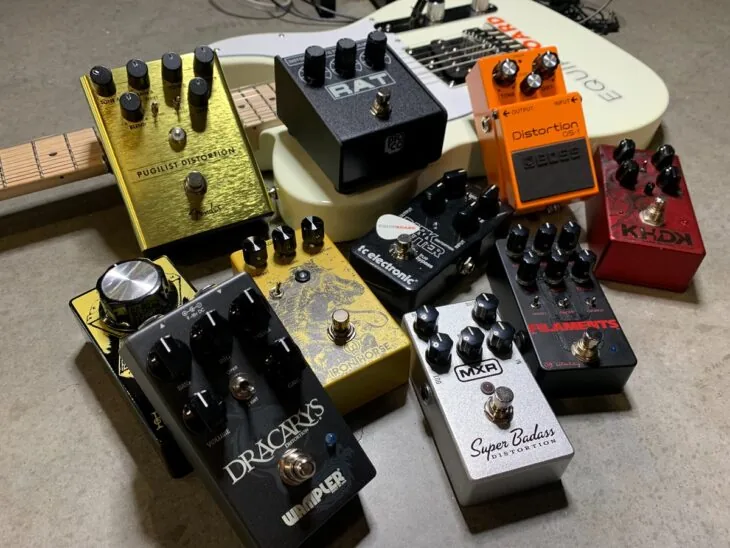
If you were to name one feature of rock music that defines its sound (besides guitar), I’m sure everybody would say guitar distortion. By thinking outside the box and pushing amplification to its limits, early rockers realized they could make thick, richly harmonized sounds.
Distortion pedals come in all types, meaning that distortion itself can sound different in different contexts.
Chuck Berry gave his blues-inflected solos a bright warmth with a light touch of distortion. Keith Richards and Jimi Hendrix soon made it central to their overall tone. By the time heavy rock and metal entered the scene, distortion was combined with volume to create thick walls of sound.
Fuzz Pedals and Overdrive Pedals
Both fuzz and overdrive pedals are similar to distortion; however, they differ by being more and less intense, respectively.
Distortion pedals increase the guitar waves enough to significantly “shred” up. Fuzz pedals take this a step further, maxing out the amplifier as much as possible. Both make significant changes to the clean tone of the guitar, but fuzz almost eradicates it completely. Many of Jimi Hendrix’s tunes used fuzz by default.
Overdrive pedals retain most of the guitar’s original tone, and only give it a slight bite when it hits higher volumes. If you’re listening to a rock song that doesn’t sound particularly “heavy,” but still has some grit, chances are they’re using overdrive instead of distortion.
Wah-Wah Pedals
Wah-wah pedals can be tilted to different angles, instead of a simple “on/off” switch. Every angle filters out different levels of high and low frequencies (in other words, the various “bass-y” and “soprano-y” overtones in each note).
While the science is tricky to explain, the result is easy to recognize. When used, it makes the guitar sound like a human voice going between “ooh” and “ah.” Hendrix used it in “Voodoo Chile,” while others include the Smiths’ “The Queen is Dead” and Slash’s solo in “Sweet Child o’ Mine.”
Delay and Echo Pedals
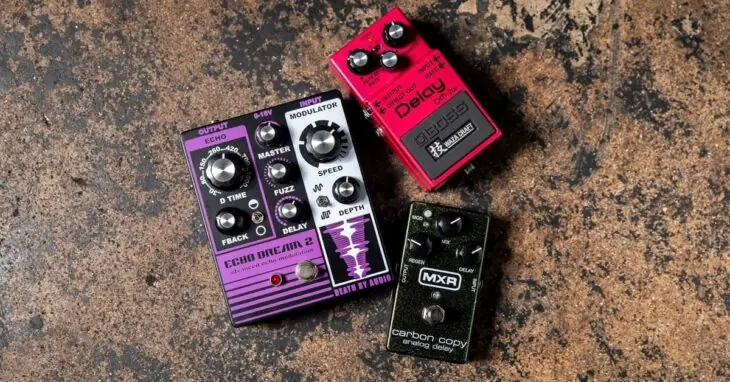
There are tons of pedals out there, and it would be outside the realm of this article to list them all. However, these are pretty standard across various subgenres and bands.
Delay and echo pedals repeat what you play. Delay repeat every part, while echo pedals make it fade with each repeat. Various settings let you dictate how often to repeat, how loud each repeat is, and how fast it repeats.
The Edge from U2 is probably the most famous delay user, as he makes it central to most of his guitar work.
Keyboards: Pianos, Organs, Mellotrons, and More!
Guitars get all the attention in rock. I can’t really get mad either, since they invented rock. However, keyboards have been just as integral as guitars in defining rock’s sound and styles.
I’ve often found that people’s knowledge of twentieth-century keyboard instruments is criminally underrated, which is a shame. So now I’m gonna fix that for ya!
Acoustic Piano
Pianos might not be as iconic rock and blues as guitars, but they’ve been used since their beginnings. Both styles use highly rhythmic, syncopated piano grooves and riffs. When not being groovy, pianos have helped define some of rock’s most beautiful ballads.
Some of rock’s most influential musicians have been pianists. Little Richard helped found the genre in the ‘50s. Billy Joel combined his classical training with jazz and rock to become one of the ‘70s most beloved musicians.
Other influential rock pianists have flown under the radar their entire careers. Most prominent among them is Nicky Hopkins, who played sessions for the Rolling Stones, the Beatles, Carly Simons, Jeff Beck, Jerry Garcia, and countless others.
Electric Pianos: Rhodes and Wurlitzers
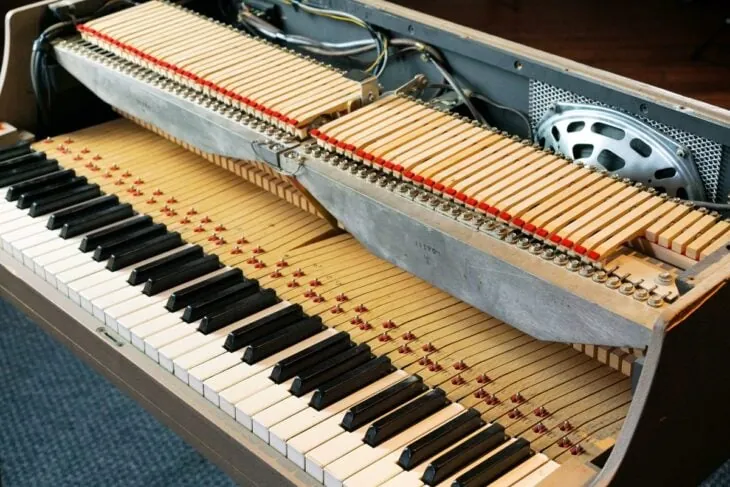
Rock piano doesn’t end at acoustic pianos. Electronically amplified pianos, which function similarly to electric guitars, have also left their mark. The most famous electric pianos in rock are probably the Rhodes and Wurlitzer pianos.
Both use real lever systems, as well as hammers and wires. Under each wire (called a “tine”) is a pickup that carries the electric signal to an amp – just like a guitar! Both will give a nice overdriven effect if pressed hard enough.
Wurlitzer players include Ray Charles and Joe Zawinul, who played with Miles Davis during his electric jazz period. Rhodes players include Billy Preston, Stevie Wonder, and Ray Manzarek – all of whom made a huge impact with its use.
Billy infused it with jazz and soul, lending the Beatle’s his solo for “Get Back.” Stevie Wonder paired it with wah-wah pedals, giving his funk tunes a particular groove. Lastly, Ray Manzarek defined the sound of the Doors by making them piano-centered instead of guitar-centered.
Hammond Organs
If there’s any keyboard instrument that can rival the electric guitar in drive and bravado, it’s the Hammond organ. Another unsung hero of rock, the Hammond organ has been delivering colossal riffage since the early 60s.
Electric in design, the Hammond organ’s drawbars allow a user to creatively manipulate its sound. Paired with its airy sound and siren-like Leslie speaker, it provides a gleefully “imperfect” sound to rock tunes.
Iconic uses of the Hammond organ include Alan Price’s solo in the Animal’s “The House of the Rising Sun” and Jon Lord’s distorted riffs throughout Deep Purple’s entire catalog.
Mellotrons and Solinas
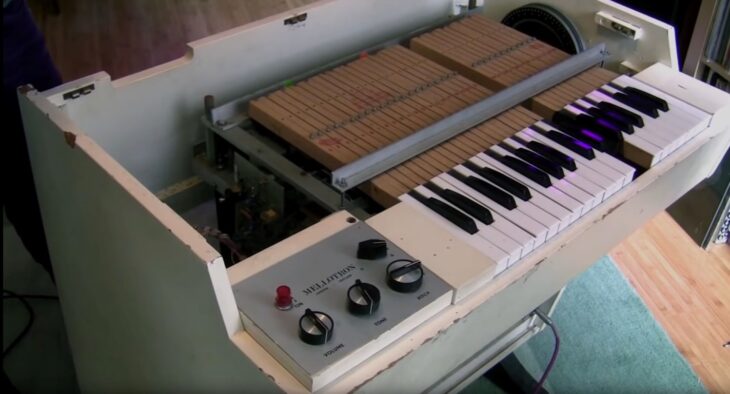
Mellotrons are quirky instruments originating from the 60s, but they sure have left an impact on rock. Functioning as the original “samplers,” each key was paired with a physical tape that replayed prerecorded strings, voices, flutes, or trumpets.
Interestingly, even though many people haven’t heard of them, they’ve been used in some of rock’s most famous tunes. These include the Beatle’s “Strawberry Fields Forever,” Led Zeppelin’s “Stairway to Heaven,” Oasis’s “Wonderwall,” and Radiohead’s entire discography!
In a similar vein, the ARP String Solina was a strings-centric synth used in the ‘70s and ‘80s. It was used in David Bowie’s Heroes record, and helped define the Cure’s goth and pop sounds.
Synthesizers
Like pedals, synthesizers are very diverse and complex. However, one thing is sure: they have aided rock musicians in creating some truly unique and innovative sounds throughout the decades.
Bob Moog invented the first mainstream synthesizer in 1964. Earlier adopters of his synths included Pete Townshend (the Who), George Harrison (the Beatles), and Bob Marley. Early uses can be heard in the Beatle’s “Here Comes the Sun” and Marley’s “Stir it Up.”
Over time, synthesizers increased their sounds and capabilities. If synthesizers sound interesting to you, a fascinating journey of discovery awaits you. Despite their widespread usage in rock, very few people really know how they work!
Classical Influence
Rock started as a form of popular music and remains primarily in this market. However, rock musicians have always been looking for ways to integrate academic music – both its sounds and ideas – into their rock aesthetic. The results are both beautiful and intriguing.
The Beatles were one of the first bands to incorporate classical instrumentation into their tunes. Paul McCartney, with the advice of George Martin, decided to include a string quartet in “Eleanor Rigby.”
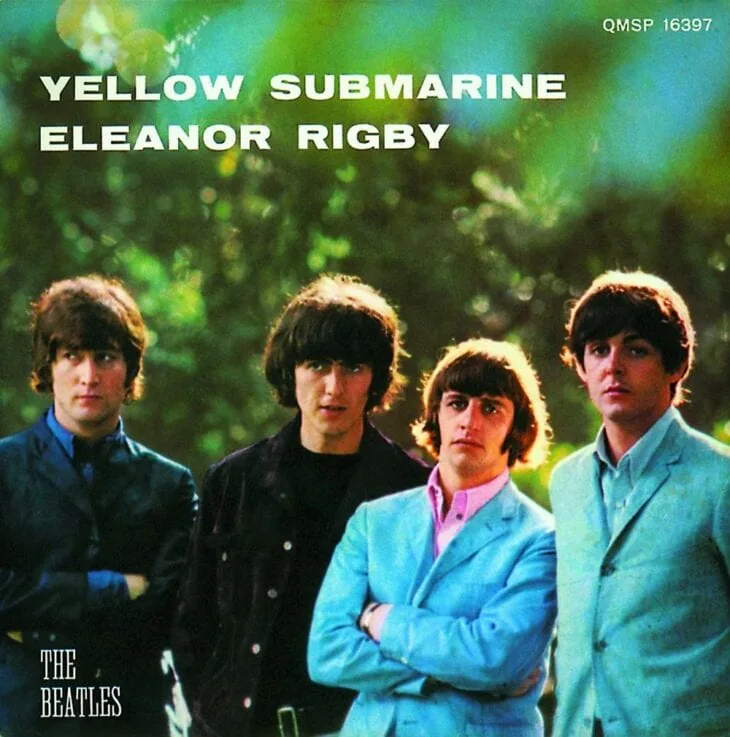
The Beatles would continue their classical experiments, incorporating harp, flutes, trumpets, and even atonal orchestras into their later work! Rock bands have been experimenting ever since.
Perhaps the most famous classical/rock integrator today is Jonny Greenwood in Radiohead. Equal parts rock and classical musician, Greenwood has made it a point to mix avant-garde classical techniques into various Radiohead projects.
International Influences
Music is a product of people, experiences, and cultures, and our world is incredibly diverse (duh!!) Inevitably, curious musicians of all types will eventually seek to mix musical traditions together from all over the world.
In the 1960s, Western rock musicians were fascinated by Indian classical music, thanks to a cultural interest in Eastern philosophy. The Beatles used the sitar and table in various tunes, as well as Brian Jones of the Beatles.
In the 1970s, David Bowie moved to Germany to kick his cocaine addiction. While there, he fell in love with German “krautrock.” The result was his “Berlin trilogy,” a delightful mix of English and American rock with German sentiments.
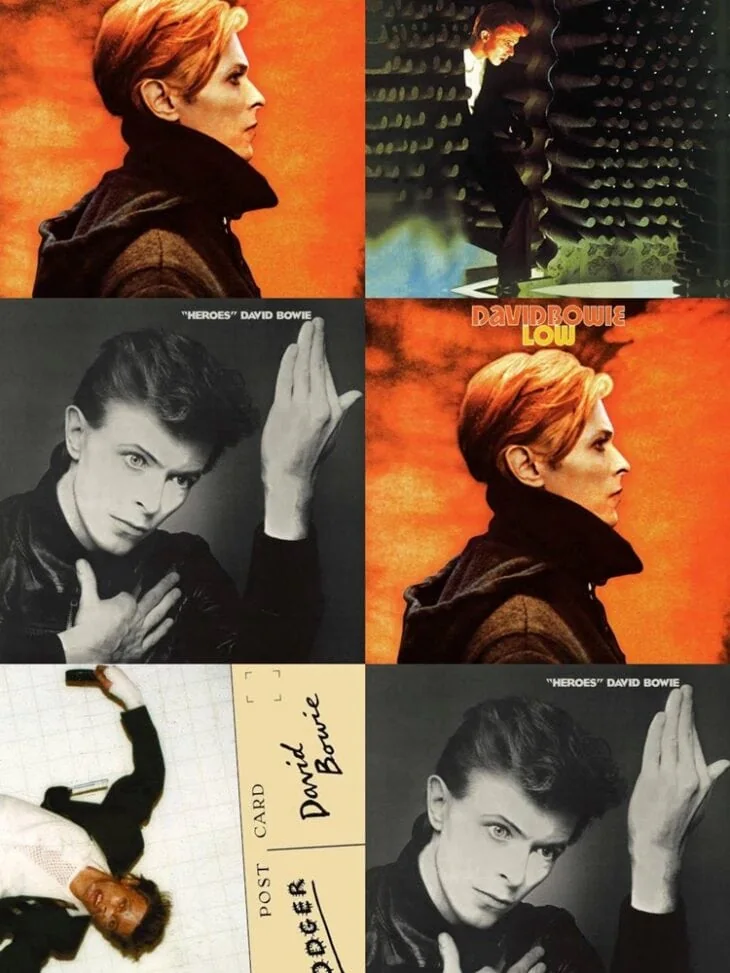
Other examples include the reggae-influenced punk tunes of the Clash and South African traditions on Paul Simon’s Graceland. All to say, if you’re interested, just start googling … I’m sure someone out there has mixed rock with your favorite world music!
Conclusion
While rock originated as teenage, electric guitar-driven music of the ‘50s, it has evolved into an incredibly diverse array of styles and traditions. This is a reflection of art’s remarkable power; each genre, at the end of the day, is a grand study in human experience, creativity, and interaction.
Hopefully, this article encouraged you to see rock as more than “guitar music,” and maybe even inspired you to take your music in a whole new direction! Whatever you do, your music can still follow in the proud heritage of rock music.
Until next time, enjoy exploring new rock instruments, and always, ALWAYS have fun!

